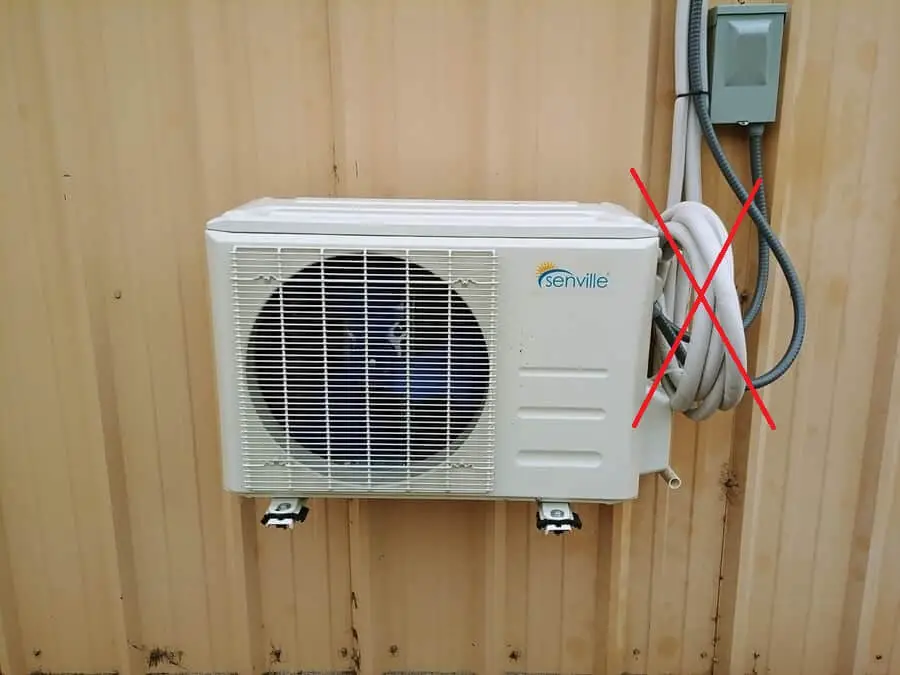Good refrigeration line principles for mini splits are no different than any other heat pump or air conditioner. You can run a ductless line set up, down, or straight out. Try to keep away from forming traps or letting the pipe sag or droop. Secure the pipe as often as possible, at least every four feet.
The image below shows a mini split with the line set running up which is great. The problem you should avoid is having loops in the lines that can create traps of oil that can reduce refrigerant flow.

These loops could have been created to allow a certain minimum length that manufacturers require. Just do your best. In some cases, a little sage is almost impossible to avoid.
Follow your manufacturer’s instructions for the total length. Each manufacturer of ductless mini splits will have explicit directions regarding how much additional length of refrigeration pipe will be allowed. Adding footage to piping also increases the amount of refrigerant needed to keep the compressor cool and can slightly reduce efficiency.
These line sets carry refrigerant. Refrigerants are sometimes referred to as Freon. Freon is a brand name. The most common refrigerant used in mini splits is R-410A. It’s a gas that boils at a very low temperature. The compressors in mini-split systems have synthetic oil in the bottom to lubricate the moving parts.
The oil and the refrigerant mix together slightly, and some oil moves through the copper tubing with the refrigerant in a cycle that returns the oil to the compressor.
Running Mini Split Lines Up In Walls
I like to run these lines in the walls whenever possible. Nothing is more unsightly on the outside of a wall than a bunch of pipes and wires strung in the open. It has a lot to do with aesthetics and pride a person might take in the work they want to look at for the life of the installation.
Ductless line set covers help to neaten up the mess that’s on the outside of a wall, but the disruption is still there staring you in the face every time you or a visitor walks by. When line sets are inside of walls that will be covered extreme care needs to be taken to prevent nails and screws from penetrating the lines during the cover process.
Use nail plates to cover anything that a possible nail or screw could penetrate the copper tubing or nick the power cable.
I was on a job in a restaurant not long ago. Troubleshooting a refrigeration system. Every time we would touch the stainless sink we’d get a shock. 120 volts to ground from the sink. Started pulling out the mounting screws on the back plate of the sink and finally found the culprit.
Take a long enough screw and put it an unprotected place and you have a potential killer.
Can I Bury Refrigerant Line Set Underground?
Only if you want an unexpected bad reaction. Copper lines, especially those connected to motors and electrically operated equipment will be subject to electrolysis.
Have you ever seen that green stuff on copper pipe. When copper is buried and subject to the moisture and the grounding effect of being in the dirt it will corrode.
There are ways to install refrigeration pipes underground in a very safe manner, ensuring that they stay preserved.
Inserting the line set into a flexible tubing like (ad) Advanced Drainage Systems 04510100 Solid Singlewall Pipe, 4″ x 100′ you can keep moisture away from the copper. Be sure it’s not the slotted type for drainage pipe.
The ends of the HDPE tubing need to be sealed so sprinkler systems, rain, and melting snow will not contaminate the underground pipe. Spray foam seems to work well for sealing the ends of the lines,
Be careful not to create traps in the line that could accumulate oil inside the line, creating a loss of pressure. It’s not likely, but it’s just good practice. Keep all the lines as straight and direct as possible.
Refrigerant has this preoccupation to seek out the coldest place and accumulate in a liquid state. That’s why a lot of compressors have crankcase heaters. The liquid refrigerant will crawl under the oil in the compressor and when the compressor starts it can wash out all the oil, leaving the compressor without needed oil.
Burying the line set underground can create a cold spot for liquid refrigerant to accumulate and subsequently slug the compressor with liquid. Compressors are meant to pump only vapor.
Is There A Ductless Line Set Minimum Length?
I learned this the hard way. I installed a 12,000 BTU mini-split heat pump for a friend. Always happens when you do favors, right? It wouldn’t reverse and heat. It would only work in cool mode.
The distance from the indoor head was a total of about 8 feet.
After contacting tech support and discussing all the symptoms, including all the installation details such as the length of the line set, I was told to weld back on some tubing and make the total length no less than 12 feet.
I had my doubts, but what else could I do?
Pumped out all the refrigerant, welded on some more tubing, evacuated the system, and recharged the mini-split.
It still didn’t heat.
Called back tech support and my first suspicion came true. We had a defective control board.
A new board arrived and that solved the problem.
But, to answer the question, is there a minimum length for a mini split’s line set? Yes, there is. Follow the instructions. One of my biggest weaknesses. It started on my first Christmas. Just open the box and figure it out.
Conclusion
Read the instructions. Keep everything clean, straight, and as plumb as possible.

